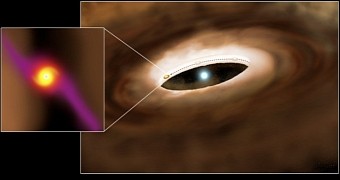Evidence presented in a recent paper in The Astrophysical Journal indicates that a brand new planet is forming at a distance of just 335 light-years from us. This planet is coming into being in the proximity of a star dubbed HD 100546.
Scientists base their claim that our home galaxy is on the verge of acquiring a new planet on data obtained with the help of the Gemini Observatory and the Very Large Telescope at the European Southern Observatory during investigations carried out in 2003, 2006, 2010, and 2013.
The birth of a planet
As detailed in The Astrophysical Journal, researchers are yet to actually catch a glimpse of this new planet they suspect is now forming not far from Earth. Thus, the evidence hinting at the birth of new planet is a cloud of hot gas that appears to be orbiting the star.
Science Daily tells us that that this blob of hot gas was documented while astronomers were busy studying the makeup of the protoplanetary disk surrounding HD 100546. Such protoplanetary disks are basically large disks of material that swirl around stars and that can birth planetary systems.
Previous investigations have shown that apart from space dust, protoplanetary disks pack considerable amounts of gas. In the case of HD 100546, however, the encompassing disk was found to accommodate for an unusual source of gaseous emissions.
This peculiar source of gaseous emissions is now argued to be no more and no less than gas circling a forming planet and adding to its mass. If astronomers are right and this gas is indeed fueling the birth of a new planet, the resulting celestial body is expected to be a gaseous giant about three times the mass of Jupiter when finally coming into being.
“These results provide a rare opportunity to study planet formation in action. Our analysis strongly suggests we are observing a disk of hot gas that surrounds a forming giant planet in orbit around the star,” researcher Dr. John Carr with the US Naval Research Laboratory said in a statement.
“While such circumplanetary disks have been theorized to surround giant planets at birth and to control the flow of gas onto the growing planet, these findings are the first observational evidence for their existence. If our interpretation is correct, we are essentially seeing a planet caught in the act of formation,” he added.
What next?
Researchers plan to continue studying HD 100546 and the recently documented source of gaseous emissions that appear to be orbiting it, and hope to soon gain a better understanding of the makeup of the supposed circumplanetary disk they pinned down with the help of the Gemini Observatory and the Very Large Telescope at the European Southern Observatory.
The bad news is that, in about two years' time, this alleged forming planet in the proximity of said star will disappear from sight. The celestial body should make a comeback 15 years later, when its orbit will bring it back into sight. Hopefully, by then astronomers will have managed to figure out what exactly is happening in the protoplanetary disk surrounding HD 100546.

 14 DAY TRIAL //
14 DAY TRIAL //